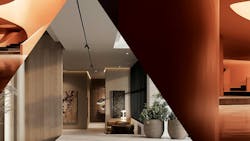INDUSTRY INSIGHTS | Report says lighting market should capitalize on these trends
As we move to the halfway point of 2024, Cincinnati-based building environment industry (BEI) marketing agency AMBI has considered the key differentiators and points of discussion that have emerged with clients working in and supplying projects in the built environment. Although lighting brands will need to engage the buying market with their “unique identity and value proposition,” the company noted that manufacturers should address five trends that will continue to inform the industry this year and beyond.
No. 1: Actions take priority over sustainability slogans and certifications.
“While many lighting brands discuss their sustainability efforts, very few embody it,” AMBI said in its trend report. “The brands that can expect to outpace the competition are the ones who are actively making strides toward holistically sustainable practices.”
Indeed, the lighting market has sought methods toward achieving greater sustainability from other sectors, from life cycle assessment (LCA) techniques and environmental product declaration (EPD) development to design for disassembly, remanufacturing, and other circular economy practices.
AMBI CEO Will Sears acknowledged how the lighting community has taken cues from its BEI customers. “Many manufacturers are finally coming to the table to ensure their solutions meet more competitive, substantive sustainability standards. While certain labels and certifications are easily met and treated more as marketing than a value, the market is demanding real commitment to practices that have actual impact,” he said in response to an LEDs Magazine inquiry.
Sears noted that the pace of sustainable products and processes differs across regions and could have a trickle effect. “European manufacturers far outpace North American manufacturers [in sustainability activity] due to regulatory requirements that are ‘baked’ into the process,” he said in reply to our observation that some U.K. and European design and specification firms are requesting that lighting and building product suppliers comply with circular practices. “It is encouraging to see these standards being expected by the construction industry, even if not required — yet.”
No. 2: Integrated spaces and technologies are growing. Let them shape the products and systems on offer.
AMBI’s report defines integrated spaces as “environments that are carefully designed to adapt to human needs, emphasizing elements including productivity, wellness, and comfort.”
“As lighting designers and architects form their visions for a project, there is more interaction between lighting and the other elements of the space,” Sears elaborated. “In other words, they are no longer designing [only] the aesthetic and structure of a space, but the interactivity and function of a space as well. The surge of innovation in controls allows lighting to synchronize with shades, occupancy sensors, and myriad other elements.”
Sensors serve an array of functions including occupancy, temperature/humidity, indoor air quality, and light, providing critical data points regarding occupant behavior and building efficiency. Such controls — whether luminaire level or networked — can enable circadian effective (or melanopic) lighting, daylight harvesting, and task-tunable lighting as part of an integrated building management system. Thus, lighting should be thoughtfully designed to help optimize building environments that support wellbeing and productivity.
No. 3: Blend nature with light.
Extending the optimized environment notion, the firm observed “a noticeable shift towards creating spaces that fuse the natural world with architectural elements.” LEDs has documented trends toward more natural materials and styles that mimic the outside world, which AMBI said “[fosters] a sense of harmony within man-made spaces.”
Still, the firm concluded that no matter their style, the selection and placement of luminaires remains of paramount importance. The report cites wall washing as a “favored technique” by designers to softly illuminate and enhance particular features. In terms of products, AMBI said, micro-optic fixtures are gaining popularity due to being discreet while delivering precise beam distributions (more on that below).
No. 4: Embrace architecturally forward lighting across different price points.
While some applications call for fixtures that disappear into architectural elements such as coves or embed into surfaces, other luminaires will provide a focal point with their aesthetic value, the firm predicted. And luxury brands aren’t the only ones called upon to kick up the ambience, according to the report. “Even value-driven brands are recognizing the demand for visually pleasing light fixtures that combine functionality with style and offering product lines that fulfill this intent,” the firm observed.
Sears also mentioned several form factors and design concepts that are rising in popularity. As noted in the report, the micro-optic linear form is one designed to blend seamlessly into the space, but downlight form factors are also having a moment for their ability “to minimize distractions away from the design and cohesive vision of a space,” he said.
Each trend plays into another, Sears further explained. “The capacity to make micro-optic lighting a sustainable solution is also aligned with trends and requirements in the industry, so it’s a win-win,” he said. And at the same time that “the prominent rise of biophilic design is leading architects and lighting designers to look for minimalist solutions that are meant to be felt more than seen” in some instances, Sears said, “[it] is also leading decorative lighting manufacturers to design products that contain sustainable, natural materials that beautifully integrate with other biophilic elements in the space” (see examples linked in the previous paragraphs).
No. 5: Strike a balance between price, progress, and policy.
The final thoughts from the AMBI report may be the most critical to a healthy lighting business. That leaves designers and manufacturers with the question of how to find the sweet spots between cost pressures and profits, functionality and creative expression, and progressive design and regulatory compliance.
In its report, AMBI admitted lighting is a competitive market where pricing can often lead customer decision-making, but concluded that brand messaging aligned with these trends should resonate with customers looking for lighting providers that capitalize on inventive ways to achieve sustainable, novel designs at various price levels.
“Achieving that delicate balance between meeting competitive price points and progressive legislation is paramount,” AMBI concluded in its report. The changing regulatory environment has often been seen as a headache for supply chains, manufacturers, and service-oriented firms alike. But it has also driven the adoption of energy-efficient technologies by demanding greater innovation, accessibility, and quality, such as we continue to see with the U.S. Department of Energy’s L-Prize program.
Readers can visit AMBI online for more information on marketing the convergence of creative and technical innovations for the built environment.
Special thanks to AMBI and Will Sears for providing the framework and additional quotes for this industry trends piece, edited with commentary by Carrie Meadows.
Follow our LinkedIn page for our latest news updates, contributed articles, and commentary, and our Facebook page for events announcements and more. You can also find us on the X platform.

Carrie Meadows | Editor-in-Chief, LEDs Magazine
Carrie Meadows has more than 20 years of experience in the publishing and media industry. She worked with the PennWell Technology Group for more than 17 years, having been part of the editorial staff at Solid State Technology, Microlithography World, Lightwave, Portable Design, CleanRooms, Laser Focus World, and Vision Systems Design before the group was acquired by current parent company Endeavor Business Media.
Meadows has received finalist recognition for LEDs Magazine in the FOLIO Eddie Awards, and has volunteered as a judge on several B2B editorial awards committees. She received a BA in English literature from Saint Anselm College, and earned thesis honors in the college's Geisel Library. Without the patience to sit down and write a book of her own, she has gladly undertaken the role of editor for the writings of friends and family.
Meadows enjoys living in the beautiful but sometimes unpredictable four seasons of the New England region, volunteering with an animal shelter, reading (of course), and walking with friends and extended "dog family" in her spare time.







